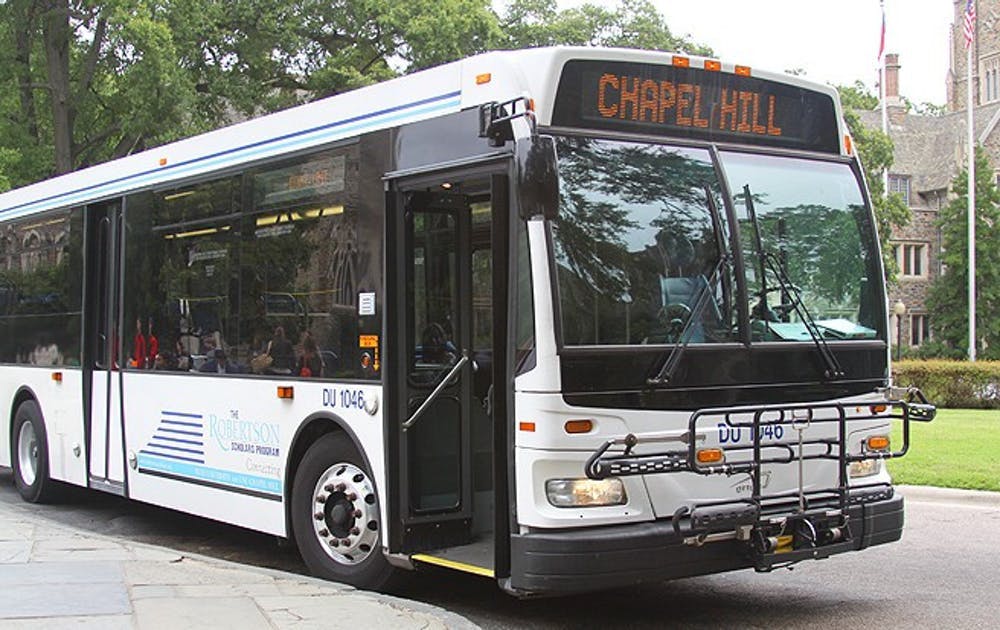The independent news organization of Duke University
Editor’s note: This story is part of a series unpacking Duke’s response to the Aug. 28 shooting at the University of North Carolina at Chapel Hill. The second part, which follows Robertson Scholars who were either on or about to go on UNC’s campus as the situation unfolded, will be published later this week.
On Aug. 28 at 1:03 p.m., the University of North Carolina at Chapel Hill’s emergency alert system, Alert Carolina, released a text blast indicating that an armed and dangerous person was present on or near UNC’s campus.
Duke sent its own alert at 4:06 p.m. — over three hours after the initial Alert Carolina — informing students, faculty and staff that there was an “armed and dangerous” person reported on the UNC campus and that the event posed “[n]o threat on Duke’s campus.”
By then, the threat at UNC was nearly cleared. Six minutes after the DukeAlert, UNC announced its all-clear signal. Schools in the Chapel Hill Carrboro City District, which went on lockdown at 1:41 p.m., began their dismissal processes after authorities announced an all-clear at 3:40 p.m. The News & Observer reported after the events unfolded that the suspect, Tailei Qi, was detained by police approximately an hour-and-a-half after the initial alert from UNC.
That evening, UNC Police announced that a faculty member, later identified as Zijie Yan, an associate professor in UNC’s department of applied physical sciences, was the victim of the shooting.
The first DukeAlert was released over three hours after the initial Alert Carolina announcement. Meanwhile, Duke students planned to make the trip to Chapel Hill in the time it took for the DukeAlert to be sent out.
According to Frank Tramble, vice president for communications, marketing and public affairs, the University’s leadership was aware of the events on UNC’s campus “as soon as law enforcement there were involved.”
UNC Police first reported an “[a]rmed, dangerous person” on campus at 1:03 p.m., and Tramble wrote that Duke administrators “continued to monitor events in Chapel Hill closely throughout the day.”
“Once we established there was no evidence of danger to the Duke campus, our priority became taking the time necessary to ensure any information we shared was accurate and confirmed,” Tramble wrote.
A Robertson Express bus, which runs between Duke and UNC, was at Duke at the time the incident was reported and “remained [at Duke] with service suspended until the next morning,” according to Tramble.
Duke Today, a news service produced jointly by two University communications teams, later announced that it stopped bus service to UNC and urged people to stay away from the UNC campus.
Tramble wrote that the Duke Today article and an identical email sent by Russell Thompson, Duke’s interim vice president of operations, at 2:51 p.m. to senior leadership, academic department chairs and managers informed the “entire Duke community” of the events unfolding on UNC’s campus.
However, several students, including those who were planning on arriving on UNC’s campus, told The Chronicle that they not only found out about the shooting from non-University sources, but also learned about it hours after UNC’s initial alert.
At 4:06 p.m., Duke released its first direct communication to students through its DukeAlert. The University followed up at 4:32 p.m., announcing that UNC issued its all-clear signal about 20 minutes earlier.
DukeAlerts are emergency alerts sent via SMS text messages to faculty, staff and students registered via Work@Duke or DukeHub.
The first DukeAlert sent in response to the UNC students informed recipients that there was no ongoing threat on Duke’s campus, even though DukeAlerts are typically used in cases of “imminent danger.”
“The subsequent DukeAlert was sent to ensure awareness as widely as possible across Duke so people could adjust any plans, since the incident was still ongoing as the end of the work day was approaching,” Tramble wrote.
DukeAlerts are only one part of Duke’s emergency response plan, which can include “email, text messaging, web, phone, an outdoor warning system, campus digital signboards and the LiveSafe mobile app.”
Duke is required to send alerts about crimes within “campus property, public property adjacent to and going through campus, and certain non-campus property that Duke leases or otherwise controls.”
“These crimes are evaluated on a case-by-case basis to determine if they represent an ongoing threat to the campus community and whether notification will aid in the prevention of similar crimes,” the Office of Audit, Risk and Compliance wrote on its website.
However, emergency response to off-campus threats is more complicated.
According to the University’s 2022 Annual Clery Security Report, Duke does not own “off-campus housing or student organization facilities,” nor does it have “officially recognized student organizations that own or control housing facilities outside of the Duke University core campus.”
As such, outside law enforcement is not used for “monitoring and recording criminal activity” since there are no officially recognized off-campus locations of student organizations.
Emergencies at properties distant from Duke’s campus can be handled “either entirely by the local law enforcement agency with jurisdiction” or by similar agencies that are supported by the Duke Police.
Signup for our weekly newsletter. Cancel at any time.
Jothi Gupta is a Trinity sophomore and a university news editor of The Chronicle’s 119th volume.
Audrey Wang is a Trinity junior and editor-in-chief of The Chronicle’s 119th volume.
Share and discuss “A look into Duke’s emergency response to the UNC shooting” on social media.
facebook twitter
A look into Duke's emergency response to the UNC shooting – Duke Chronicle

